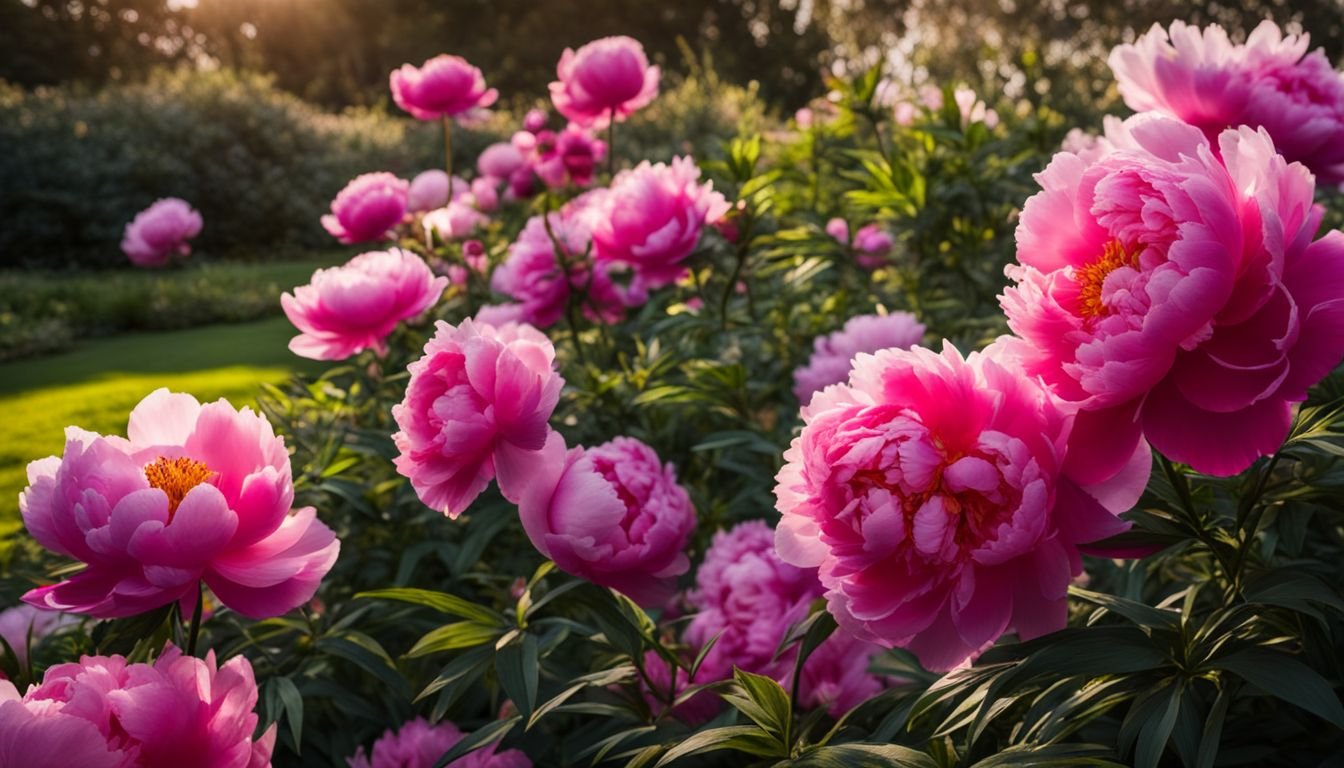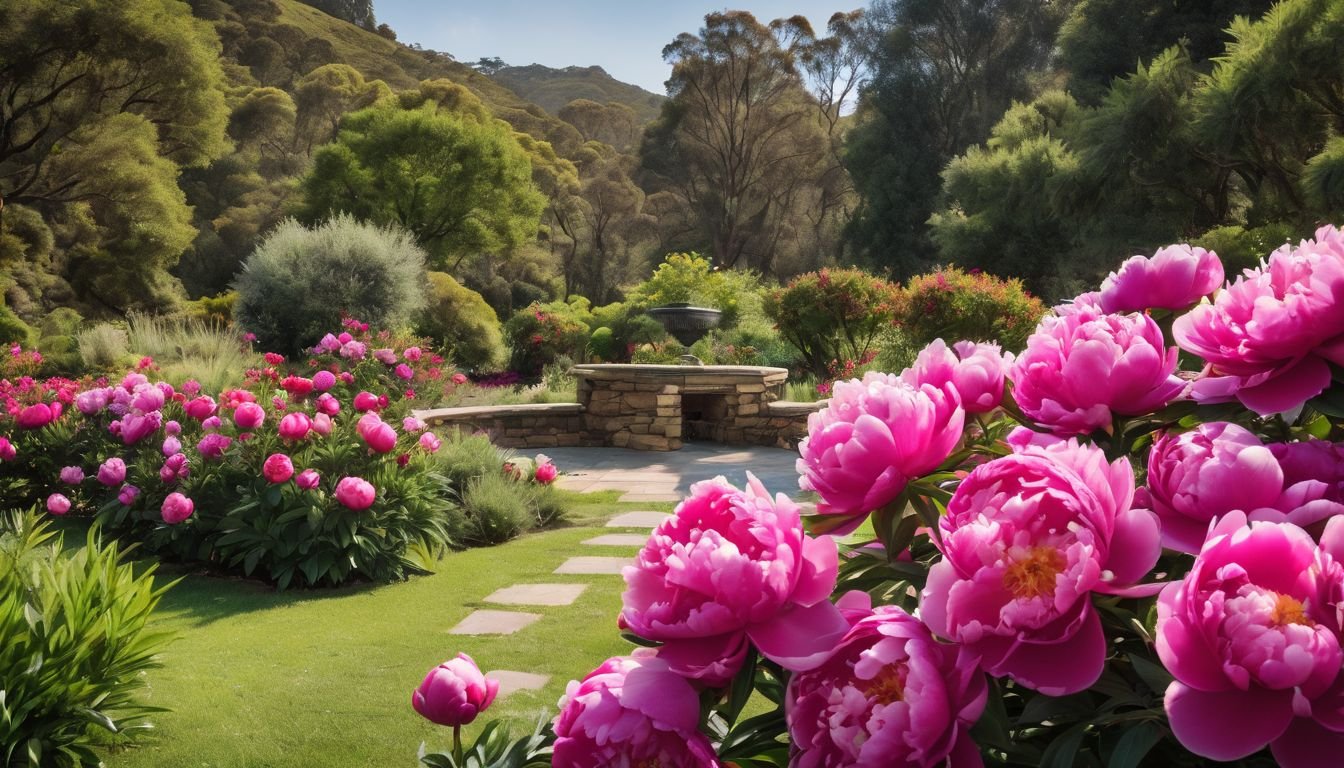Peonies might puzzle Australian gardeners, who often wonder why these stunning flowers seem so elusive in their own backyards. These luscious blooms, cherished for their vibrant hues and sweet scent, can thrive under the Aussie sun with the right know-how.
Our guide demystifies peony care, offering straightforward steps to cultivate a flourishing peony haven at home. Dive into the world of peonies and transform your garden into a blooming paradise!
Key Takeaways
- Peonies can be a successful and stunning addition to Australian gardens with the right care; they prefer well-drained, fertile soil, some sunlight with afternoon shade in hotter regions, and protection from strong winds.
- There are several types of peonies available such as herbaceous, tree, Itoh, and coral peonies—each with distinct growth habits and flowering characteristics suited to Australia’s varying climates.
- Proper watering is essential for peony care—aim for moist but not waterlogged soil; complement this by pruning in autumn and applying mulch for root protection.
- Propagation techniques including root division, seed propagation, cuttings, and grafting enable gardeners to expand their collection or rejuvenate old plants specifically adapted to local conditions.
- Peonies offer both aesthetic value with their vibrant hues and fragrances as well as longevity in the garden if maintained properly. They are an ideal choice for adding long-term beauty to any outdoor space.
Understanding Peonies

Delve into the enchanting world of peonies, a beloved genus that captivates with its lush blooms and fascinating varieties. From their distinctive morphology to the diverse array of species, get ready for an insightful journey into these cherished garden gems.
Description and Morphology
Peonies dazzle with compound, deeply lobed leaves and expansive, fragrant blossoms that paint the garden in a palette of striking colours. They’re not just eye candy; these plants boast versatility as well, existing both as lush herbaceous perennials or robust woody shrubs.
Their flowers stand out against the greenery, offering a feast for the senses with a variety that boasts over 7,000 cultivars registered by the American Peony Society.
Diving deeper into their form reveals two primary growth habits: herbaceous peonies die back each year only to rebound with vigour come springtime, while tree peonies maintain woodier stems annually.
These botanical beauties serve not only as garden centrepieces but also as cut flowers adorning homes and events with their elegance and perfume. Now, let’s explore the various types of peonies you might consider adding to your Australian oasis.
Peony Varieties
Peony enthusiasts have much to celebrate with the diverse array of varieties available in Australia. These blossoming beauties offer a range of colours, forms, and growth habits to enhance any garden.
- Herbaceous Peonies showcase lush foliage that dies back in winter, with an impressive comeback each spring. Known for their traditional “peony rose” appearance, they thrive in cooler Australian regions and are loved for their large, fragrant blooms.
- Tree Peonies stand out as woody shrubs that maintain their structure year – round. Their larger flowers and higher stature make them striking features in any landscape. Unlike herbaceous relatives, tree peonies don’t die back to the ground but instead grow slowly into magnificent specimens.
- Itoh Peonies are prized hybrids combining the best traits of tree and herbaceous peonies. They offer unique colours and strong stems that hold up large, showy flowers without staking – a true gem due to both their beauty and rarity.
- Coral Peonies captivate with shades ranging from soft peach to vibrant coral. These varieties are particularly eye-catching and bring a pop of warm colour to early-season gardens.
Cultivating Peonies in Australia

Peonies bring a touch of majesty to any Australian garden, yet mastering their cultivation requires understanding the unique conditions they thrive in down under. By tuning into the specific needs of these lush blooms, Aussie gardeners can unlock the secret to vibrant peony displays that captivate and enchant all season long.
Ideal Planting Conditions
Selecting the perfect spot for your peonies is crucial, and Australian gardens offer plenty of great options. Aim for well-drained, fertile soil with a neutral pH to encourage robust growth.
These blooms thrive in generous sunlight but also appreciate some afternoon shade in hotter regions; just make sure they’re shielded from strong winds that can damage their delicate petals.
Autumn is the prime time for planting to give your peonies a head start at setting roots before winter arrives. Be cautious not to bury them too deeply – keeping the eyes of the root only 2-3cm beneath the surface ensures they’ll be ready to burst into bloom when spring comes around.
Good air circulation is key, so space them out appropriately and keep an eye on watering needs without going overboard—this helps dodge common issues like powdery mildew or dreaded root rot.
Moving forward, let’s delve into understanding how these plants grow throughout different seasons.
Plant growth habits
Peonies burst into life each spring, forming robust mounds of lustrous, dark foliage that set Australian gardens alight with their vigour. As temperatures rise, they erupt in a spectacle of large, sumptuous blooms—these flowers are not just a feast for the eyes but also prime picks for creating stunning floral arrangements.
Tree peonies stand apart with their unique growth habits that suit the variable climates down under. Unlike herbaceous peonies that die back to the ground each winter, tree peonies maintain woody stems year-round.
This hardy nature allows them to become well-established fixtures in gardens, providing structure and enduring beauty season after season.
Propagation Techniques
Propagation techniques are essential for expanding your peony collection and rejuvenating old plants. Here’s how to propagate peonies effectively in Australian gardens:
- Root Division: This traditional method is best performed in the fall. Begin by gently digging up mature peony plants, usually at least 3-5 years old. Carefully divide the root ball into smaller sections, ensuring each has at least three to five adventitious buds.
- Seed Propagation: While slower than division, growing peonies from seeds can be rewarding. Harvest seeds from spent blooms and plant them in well-draining soil. Germination may take several months and flowers will not bloom for several years.
- Cuttings: Take semi-hardwood cuttings of herbaceous peonies during late summer. Dip the cut end in rooting hormone powder and insert them into a mixture of sand and peat moss until roots develop.
- Grafting: For tree peonies like Paeonia suffruticosa or Paeonia delavayi, grafting onto herbaceous peony stock proves effective. Collect woody stems as scions and join them to rootstocks using a whip-and-tongue grafting technique.
Caring for Peonies
Nurturing peonies in your Australian garden goes beyond mere planting; it’s about understanding their precise water and nutrient needs to ensure they thrive. Regular maintenance, including correct pruning techniques, plays a vital role in the health and floral display of these stunning perennials.
Watering and Feeding Requirements
Peonies rely on a balanced approach to watering, needing enough moisture for their thick storage roots and finer feeder roots that absorb water and essential minerals. During the growing season, it’s vital to keep the soil consistently moist but well-drained; overwatering can lead to root rot, which is detrimental to these perennials.
Apply water at the base of plants early in the day to allow foliage time to dry and avoid fungal diseases.
Feeding peonies should be done with care; a low-nitrogen fertiliser is best applied when shoots are around 3 inches tall. Avoid placing fertiliser too close to stems as this can damage them.
Compost or well-rotted manure added annually provides nutrients and improves soil structure without the risk of chemical burn. Remember, healthy feeding encourages lush foliage and vibrant blooms that have made peonies a beloved addition in Australian gardens.
Pruning and Maintenance Tips
- Start pruning in autumn when leaves begin to yellow. This is a clear sign that the plant has entered dormancy, and it’s safe to remove old foliage.
- Cut stems back to just above ground level for herbaceous peonies. Ensure you do this carefully, leaving about 3-4 centimetres of the stem.
- Dispose of any fallen leaves or debris around your peonies. This reduces the risk of fungal diseases which can overwinter in decaying plant material.
- Support developing tree peony branches with stakes. Because these varieties develop woody stems, they may require additional support as they grow taller.
- Apply a layer of mulch after pruning to protect roots from extreme temperatures. Organic mulch provides insulation during colder months and helps retain moisture during hot spells.
- Check for signs of pests like aphids or fungal diseases such as botrytis. Early detection allows for prompt treatment before issues escalate.
- Refresh mulch in spring without piling it against the stems. This minimises chances of rot while continuing to suppress weeds and maintain soil moisture levels.
- Avoid cutting flowers in their first year; allowing them to grow strengthens the plant. In subsequent years, cut flowers with long stems as this encourages new growth and more buds.
Creating Beautiful Peony Bouquets
Selecting peonies for your bouquet starts with colour and shape preferences. Look for blooms at various stages, from tight buds to full flowers, to add depth and life to your arrangement.
Choose a mix of paeonia lactiflora or the exotic paeonia suffruticosa to introduce a variety of textures. Trim stems at an angle before placing them in water; this increases their ability to soak up moisture, which extends their vase life.
Arrange your peonies with care, allowing each flower space to breathe and show off its beauty. Consider adding foliage from the peony bushes themselves or other garden greens for contrast and fullness.
Make sure you change the water regularly and keep your bouquet out of direct sunlight; these simple steps will help maintain the vibrant colours and delicate fragrances of these cherished blooms.
Benefits of Peonies
Peonies enrich Australian gardens with their lavish blooms and enduring nature, inviting gardeners to discover the full spectrum of their charm.
Aesthetic Appeal
Peonies transform gardens into showcases of color and elegance. Their sweet fragrance and layers of soft, luxurious petals craft a visual feast that captures the eye and heart. Imagine walking through your garden as the peony’s perfume lingers in the air, turning every stroll into an enchanting experience.
Glossy foliage crowns these plants in spring, with bushes unfurling huge blooms that demand attention. Garden lovers revel in their display, often choosing varieties like Coral Peonies or Romance Collection Peonies for their radiant hues and abundance of flowers.
These blossoms create a stunning impact whether nestled among greenery or cut for vases indoors.
Longevity
Peony blossoms bring long-lasting joy with their lush petals and sweet scent. These hardy flowers not only brighten gardens but persevere through the seasons, making them a favoured choice among Australian plant enthusiasts.
With proper care like mulching and judicious staking, peonies reward gardeners with robust longevity that few other plants can match.
Cultivating these perennial beauties ensures a spectacular display year after year. Their resilience is evident as they withstand various climates across Australia, from cooler southern regions to milder northern zones.
By following tailored advice for each variety – be it the classic Paeonia lactiflora or the impressive tree peonies – you will enjoy their enchanting blooms for many springs to come.
Popular Peony Varieties in Australia
Australia boasts a captivating array of peony varieties, each with unique charm and elegance that thrive in local gardens, promising to ignite the passion of plant enthusiasts seeking diverse blooms.
Herbaceous Peonies
Herbaceous peonies charm gardeners with their lush, full blooms and sweet fragrance. These perennial plants die back to the ground every winter, bursting forth in spring with a fresh bouquet of foliage and flowers.
To ensure robust growth, mulching helps retain soil moisture while staking keeps the heavy blooms upright. Careful attention to these details rewards plant lovers with a vibrant display that can last for weeks.
While current stocks are depleted, enthusiasts eagerly anticipate the return of herbaceous peonies to Australian nurseries. In the meantime, nurturing existing plants is key; applying organic compost fosters healthy roots and abundant flowering come springtime.
Next up: Tree Peonies—another stunning variety delivering exceptional beauty in our gardens.
Tree Peonies
While herbaceous peonies are a delight, tree peonies bring a different level of magnificence to Australian gardens with their woody stems and larger blossoms. These plants stand out in the spring with vigorous mounds of dark, glossy foliage and create a stunning display with their fragrant flowers, available in an array of colours.
They thrive exceptionally well in temperate regions, making them perfect for many Australian gardeners seeking to add lasting beauty to their landscapes.
Tree peonies demand attention not just for their size but also for the depth they add to any garden design. Their ability to bloom earlier than most perennials offers an enchanting prelude to summer.
To grow these resilient beauties successfully, ensure they’re planted in a spot that receives ample sunlight and has well-draining soil. With proper care, tree peonies can become the centrepiece of your outdoor haven, providing both aesthetic pleasure and an escape into nature’s embrace right in your backyard.
Itoh Peonies
Moving from the traditional elegance of tree peonies, Itoh Peonies bring a rare and captivating twist to Australian gardens. These hybrids combine the best traits of tree and herbaceous peonies, resulting in plants that are robust, with a longer lifespan and an abundance of blooms.
Known for their striking beauty and alluring fragrance, Itoh Peonies make a spectacular display with large flowers in an array of vibrant colors.
These garden gems thrive when given ample sunlight and well-drained soil—conditions often found in Australia’s diverse climate. The vigor of Itoh Peonies means they can fill a space with grace year after year without demanding constant attention.
Offering an impressive show each season, these peonies are celebrated not just for their rarity but also as a testament to successful hybridisation, making them highly sought after by those passionate about unique floral varieties.
Coral Peonies
Coral peonies bring a burst of vibrant color to Australian gardens with their stunning coral-hued blossoms. Enthusiasts covet these flowers not just for their striking appearance but also because they adapt well to the local climate, flourishing under the right conditions.
To ensure these peonies reach their full potential, gardeners should focus on providing ample mulch and support stakes, which are vital elements in the care regimen of this particular variety.
Gardeners can choose from an array of coral peony collections that offer diverse colors, scents, and profusions of blooms. Securing plants from reputable suppliers is key; many offer catalogues at no cost if you sign up for mailing lists.
This insider access lets gardeners stay ahead of the curve when it comes to availability and selection—making sure they can add these extraordinary plants to their floral havens season after season.
Conclusion
Embrace the joy of cultivating peonies to transform your Australian garden into a vibrant tapestry of colors and fragrances. Remember that these lush blooms thrive with just the right touch of care and attention.
Keep their soil nourished, provide ample sunshine, and watch as they grace your space year after year. Peonies aren’t just plants; they’re a long-term investment in beauty and serenity for your outdoor haven.
Let their flourishing petals inspire you each day as they add charm to every corner of your garden landscape.
Discover how to create your own stunning peony bouquets with our step-by-step guide here.
FAQs
1. What types of peonies can I grow in Australian gardens?
In Australia, you can grow varieties like Paeonia lactiflora and Paeonia officinalis, which flourish in a temperate climate.
2. Do peonies require special soil conditions to thrive?
Peonies prefer neutral soil that’s well-drained but make sure it’s rich with nutrients for optimal growth.
3. When is the ideal time to plant peonies in Australia?
The best time to plant your peony bulbs is during autumn, ensuring they establish roots before the winter chill sets in.
4. How much sunlight do my peonies need?
Your blossoming peonies will need full sun to partial shade to reach their full potential and showcase their stunning colours.
5. Can I expect my paeoniaceae plants to flower every year?
Yes, with proper care including adequate watering and fertilising, your paeoniaceae should delight you with annual blooms.
6. What common pests should I watch out for when growing peonies?
Be on guard against common garden pests like aphids and thrips that might be attracted to your vibrant peony plants.
